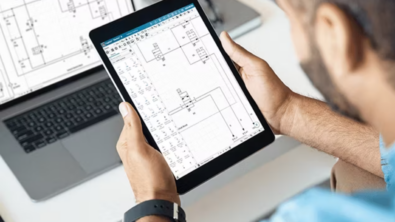Delivering electric vehicle innovation with MBSE

Manufacturers of electric vehicles (EVs) face unique challenges in designing and manufacturing compelling offerings in a market that is rapidly saturating. This blog series will examine these challenges and the effects that growing EV adoption may have on the automotive industry at large. To read part one, click here.
Part two will focus on the benefits that automotive manufacturers can realize by adopting a model-based systems engineering (MBSE) methodology, and, crucially, why they shouldn’t wait around for autonomous vehicles to get started.
Speed and complexity
The complexity of passenger vehicles has been growing steadily for decades. Now, a convergence of trends in the industry is accelerating this growth in complexity to unprecedented levels. While autonomy is among these trends, the transition to electric powertrains and the increasing importance of electronics and embedded software are creating immediate challenges for automotive OEMs (figure 1). First, as explored in the previous blog, EVs require bespoke architectures and platforms to achieve the greatest performance and drive range. A part of these new architectures and platforms is the use of new lightweight materials, component consolidation, and other strategies that increase the complexity of vehicle design.

In general, EV platforms bring previously unrelated vehicle systems together into tightly integrated, multi-domain sub-systems. The electric powertrain, for example, requires the combined efforts of mechanical, electrical, electronic and software engineers to achieve the best performance. For instance, the physical packaging of the battery pack can dramatically affect the cooling of the battery pack, and thus how the rest of the powertrain must behave to optimize the system performance and drive range. As a result, EV engineering and development is marked by a need for efficient and continuous cross-domain collaboration.
Recent trends in the automotive industry have only made the need for efficient, cross-domain collaboration more pressing (figure 2). Across the industry, development cycles are accelerating as companies strive to bring ever more advanced products to market as quickly as possible. In addition, a proliferation of new EV programs at startups, automotive OEMs and tech companies has heightened the competitive intensity for all participants and contributed to a rapid evolution of the traditional automotive business model.

These business trends, however, have been accompanied by an increase in the number and severity of automotive regulatory and compliance requirements. Moving forward, it will be even more critical that EV manufacturers maintain total traceability of vehicle requirements, functions, features and their physical implementations to prove compliance and ensure that the vehicle functions as intended. Automotive manufacturers need to adopt a methodology that facilitates cross-domain collaboration and maintains total traceability throughout vehicle development. A model-based systems engineering (MBSE) flow employs automation to accelerate development and supports collaboration through robust data integrity across engineering domains and tools.
A robust underlying data model is critical to enabling a model-based engineering flow, where data remains continuous from definition through manufacturing and service. Data continuity allows the work products from each stage of vehicle development to be used as input for the next step in the flow. This continuous digital thread of data up and down the development flow enhances the ability of engineers to manage and implement changes as well. The full impact of design changes can be understood before implementation because each domain works from the same digital thread. Once a change is verified, it can be propagated throughout affected domains and designs quickly.
Furthermore, data continuity provides traceability from functional models to the implementation and documentation of these functions in the vehicle software, networks and EDS. This traceability ensures that engineers can quickly identify the functional source of any component within the vehicle architecture, or (in reverse) find the specific ECUs, networks signals, or pins involved in the implementation of a function.
Modern software provides a foundation for MBSE
Today, E/E systems engineering solutions, such as Capital from the Xcelerator portfolio, provide the robust data model, automation capabilities and integrations necessary to effectively implement MBSE. These solutions can import functional models from various sources, use rules-based synthesis to generate detailed designs and reports, share this information across domains and track everything with a unified digital thread.
These solutions also feature built-in metrics for both logical and physical key performance indicators (KPIs), including cost, bandwidth utilization and more. These metrics can drive early optimizations and, coupled with rule-based synthesis, rapid iteration on the E/E architecture. Design rule checks can then identify violations or issues in the physical design abstraction, such as excess bandwidth or ECU utilization.
The result is a verified multi-domain vehicle platform that is already optimized for platform KPIs. As the platform is generated, the E/E engineering solution ensures data continuity and traceability from the platform back to the source functional designs. This data continuity will also support collaboration between teams and traceability as they perform the detailed design work to create the logical, networks, software and hardware systems. Each element will automatically be tied to its functional abstraction and physical implementations. A single pin on a connector in a wiring harness can be traced back to the wiring diagram, logical schematic and functional design in which it was defined.
Advanced E/E engineering solutions, like Capital, take this a step further. Integrations with product and application lifecycle management solutions (PLM/ALM), such as Teamcenter and Polarion, allow for the digital thread to extend all the way back to the product configurations, requirements and constraints. This comprehensive traceability ensures that engineers can understand each component or function in the architecture and how it was implemented, but also why it exists in the first place. As a result, vehicle OEMs can produce detailed and accurate compliance documentation automatically, without needing to hunt for information.
Modern passenger cars are highly complex multi-domain systems-of-systems built upon the interaction of mechanical, electrical, electronic and software components. EV platforms are no different, and bring additional unique challenges compared to traditional internal combustion vehicles. Managing the development of these vehicles will require a new approach; one that can stand up to the needs for collaboration, speed and traceability. MBSE, deployed on a foundation of advanced engineering software, can support these needs to help automotive manufacturers improve their processes today, and adapt to the challenges of tomorrow.


